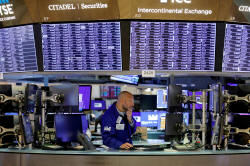U.S. junk bond funds see biggest outflows in 8 months in November
 Send a link to a friend
Send a link to a friend
 [December 02, 2021] By
Patturaja Murugaboopathy [December 02, 2021] By
Patturaja Murugaboopathy
(Reuters) - U.S. high-yield bond funds saw
their biggest outflows in eight months in November, largely owing to the
prospect of the Federal Reserve raising interest rates sooner than
expected and, to some extent, the concerns over the Omicron coronavirus
variant.
According to Refinitiv Lipper data, U.S. high-yield bond funds faced an
outflow of $4.2 billion in November - the biggest since March.
Fund flows into U.S. high yield bonds:
https://fingfx.thomsonreuters.com/
gfx/mkt/znpnexemqvl/Fund%20flows%20into%20U.S.%20high%20yield%20bonds.jpg
The ICE BofA U.S. High Yield Index, a commonly used benchmark for the
junk bond market, dropped 1% last month, the biggest fall since
September 2020.
The index's option-adjusted spread, which measures how much premium
riskier companies should pay compared with what the government pays,
widened to 367 basis points at the end of last month, from 308 basis
points a month earlier.
ICE BofA FI Index:
https://fingfx.thomsonreuters.com
/gfx/mkt/lgvdwowgrpo/ICE%20OofA%20FI%20Index.jpg
Ryan O'Malley, fixed income portfolio strategist at Sage Advisory
Services, said the main reasons for outflows from high-yield bonds were
concerns over the hit to the "reopening trade" from the Omicron variant,
particularly for the energy and transport sectors.

"The prospect of accelerated tapering of quantitative easing" has also
affected flows, he said.
The iShares iBoxx $ High Yield Corporate Bond ETF led with outflows
worth $1.35 billion, while BlackRock High Yield Bond Portfolio;
Institutional and Fidelity Capital & Income fund faced net sales of $850
million and $406 million, respectively.
[to top of second column] |

A trader works on the trading floor at the New York Stock Exchange
(NYSE) in Manhattan, New York City, U.S., August 9, 2021.
REUTERS/Andrew Kelly/File Photo

US high yield funds seeing big outflows in November:
https://fingfx.thomsonreuters.com/
fx/mkt/zjpqkykgepx/US%20high%20yield%20funds%20seeing%20big%20outflows%20in%20November.jpg
Some analysts also said investors were cutting their positions in high-yield
debt as they were not keen to carry risks into the year-end.
U.S. companies have also borrowed a record $406 billion worth of high-yield debt
so far this year, which has increased the supply of junk bonds in the market.
US high yield bond issuance hits a record high this year:
https://fingfx.thomsonreuters.com/
gfx/mkt/lbvgnlnykpq/US%20high%20yield%20bond%20issuance%20hits%20a%20record%20high%20this%20year.jpg
"There is some concern that new issue supply overshot demand, particularly in
the face of a less accommodative Fed," said O'Malley.
The uncertainty around the Fed's future rate path and low liquidity have also
increased volatility in the bond markets, prompting higher outflows from
high-yield bonds, analysts said.
The ICE BofA MOVE index, which measures one-month expected swings in U.S. bonds,
is trading at its highest level since March 2020.
"But itís important to keep in mind that while high yield is the riskiest of the
fixed-income asset classes, itís also the least risky of the risk asset
classes," said Colin Robertson, head of fixed income at Northern Trust Asset
Management.
(With additional Reporting by Gaurav Dogra in Bengaluru; Editing by Vidya
Ranganathan and Aditya Soni)
[© 2021 Thomson Reuters. All rights
reserved.] Copyright 2021 Reuters. All rights reserved. This material may not be published,
broadcast, rewritten or redistributed.
Thompson Reuters is solely responsible for this content. |